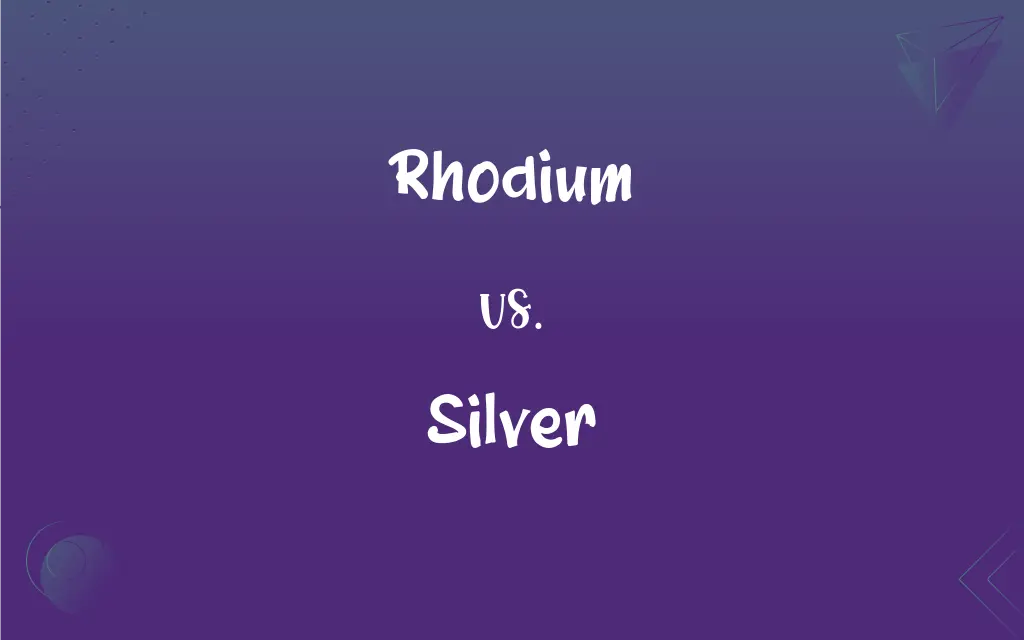Rhodium vs. Silver: What's the Difference?
Edited by Aimie Carlson || By Harlon Moss || Updated on October 24, 2023
Rhodium is a rare, highly reflective white metal, often used to plate jewelry, while silver is a shiny, versatile metal with historical monetary and jewelry use.

Key Differences
Rhodium is one of the rarest and most valuable precious metals on the planet, primarily found in platinum ores. Silver, on the other hand, is much more abundant and has been used for thousands of years for various applications, from coinage to ornaments.
In terms of appearance, both rhodium and silver have a shiny, white appearance, but rhodium is often used to plate jewelry to give it a bright, durable finish. Silver, while naturally lustrous, can tarnish over time due to its reactivity with sulfur in the air.
Economically speaking, the price of rhodium can be considerably higher than that of silver due to its rarity and demand in specific industries. Silver prices, while fluctuating, are typically more stable and driven by its use in both industry and as an investment metal.
Rhodium doesn't have the same historical background as silver. While silver has been mined and used for millennia, rhodium was only discovered in the early 19th century and doesn't share the same cultural or monetary history as silver.
In the realm of industrial applications, rhodium is prized for its use in catalytic converters to reduce automobile emissions. Silver, conversely, has a broader range of applications, from electronics to medicine, due to its conductivity and antibacterial properties.
ADVERTISEMENT
Comparison Chart
Abundance
One of the rarest precious metals
Relatively abundant
Appearance & Tarnishing
Doesn't tarnish easily; used for plating
Naturally shiny but can tarnish
Historical Usage
Discovered in the 19th century; no monetary history
Used for millennia; coins, jewelry
Price
Typically more expensive due to rarity
More stable prices; used as investment
Industrial Application
Primarily in catalytic converters
Electronics, photography, medicine
ADVERTISEMENT
Rhodium and Silver Definitions
Rhodium
A chemical element with the symbol Rh and atomic number 45.
Rhodium is often used to reduce car emissions through catalytic converters.
Silver
A metal known for its antibacterial properties.
Silver nanoparticles are utilized in some medical products for their antibacterial effects.
Rhodium
One of the most valuable precious metals.
Due to its rarity, rhodium often has a high market price.
Silver
A soft, white, lustrous transition metal with high electrical conductivity.
Silver wires are often used in electronics because of their conductivity.
Rhodium
A rare, silvery-white, hard metal part of the platinum group.
Rhodium plating gives white gold jewelry its reflective shine.
Silver
A chemical element with the symbol Ag and atomic number 47.
Sterling silver, used in jewelry, contains 92.5% pure silver.
Rhodium
A metal highly resistant to corrosion and tarnishing.
Many jewelers use rhodium to enhance the durability and shine of pieces.
Silver
A shiny metal that can tarnish when exposed to sulfur.
Silver jewelry might need periodic cleaning to remove tarnish and maintain its shine.
Rhodium
A metal typically obtained as a byproduct of mining other metals.
Rhodium is often sourced from platinum and nickel mining operations.
Silver
A metal used historically for coinage, ornaments, and utensils.
Many ancient civilizations used silver coins as a form of currency.
Rhodium
A hard, durable, silvery-white metallic element that is used to form high-temperature alloys with platinum and is plated on other metals to produce a durable corrosion-resistant coating. Atomic number 45; atomic weight 102.905; melting point 1,964°C; boiling point 3,695°C; specific gravity 12.41 (20°C); valence 2, 3, 4, 5, 6. See Periodic Table.
Silver
Symbol Ag A lustrous white, ductile, malleable metallic element, occurring both uncombined and in ores such as argentite, having the highest thermal and electrical conductivity of the metals. It is highly valued for jewelry, tableware, and other ornamental use and is widely used in coinage, photography, dental and soldering alloys, electrical contacts, and printed circuits. Atomic number 47; atomic weight 107.868; melting point 961.78°C; boiling point 2,162°C; specific gravity 10.50 (20°C); valence 1, 2. See Periodic Table.
FAQs
Is rhodium expensive?
Yes, rhodium is often more expensive than gold due to its rarity and industrial applications.
How is rhodium used?
It's commonly used as a catalyst in industrial processes, and for plating jewelry to give a shiny, white finish and added durability.
Why is rhodium plating done on jewelry?
It gives a bright, reflective finish and protects the underlying metal, often gold or silver, from tarnishing and scratching.
Does rhodium tarnish or oxidize?
No, rhodium doesn't tarnish and is resistant to corrosion.
How often should rhodium-plated jewelry be re-plated?
It varies based on wear, but every 1-2 years is common for frequently worn items.
What's the difference between sterling silver and pure silver?
Sterling silver is an alloy containing 92.5% silver and 7.5% other metals (often copper). Pure silver is 99.9% silver.
What's the symbol for silver on the periodic table?
It's represented by the symbol "Ag."
Where is silver mined?
Silver is mined worldwide, with major producers including Mexico, Peru, and China.
What is rhodium?
Rhodium is a rare, silvery-white, hard, corrosion-resistant metal in the platinum group of metals.
Is rhodium hypoallergenic?
Generally, yes. Rhodium is a good choice for those with sensitive skin because it doesn't usually cause allergic reactions.
Is rhodium a natural element?
Yes, it's element number 45 on the periodic table.
What is silver?
Silver is a shiny, white, malleable metal known for its conductive properties and use in jewelry and coins.
Why does silver tarnish?
Silver reacts with sulfur compounds in the air, leading to a dark layer of silver sulfide.
How is rhodium pronounced?
It's pronounced as ROH-dee-um.
Is silver a precious metal?
Yes, it's valued for jewelry, currency, and various industrial applications.
How can tarnished silver be cleaned?
Using a silver polish or a baking soda-water paste can help remove tarnish.
How is silver used besides in jewelry?
Silver is used in electronics, solar panels, photography, and as an antimicrobial agent, among other things.
Is silver hypoallergenic?
Generally, yes. However, some people might be allergic to metals mixed with silver in certain alloys.
What is the historical significance of silver?
Silver has been used for currency, trade, and ornamentation for thousands of years, playing a crucial role in many ancient and modern economies.
Where is rhodium found?
It's primarily extracted from platinum or nickel ores.
About Author
Written by
Harlon MossHarlon is a seasoned quality moderator and accomplished content writer for Difference Wiki. An alumnus of the prestigious University of California, he earned his degree in Computer Science. Leveraging his academic background, Harlon brings a meticulous and informed perspective to his work, ensuring content accuracy and excellence.
Edited by
Aimie CarlsonAimie Carlson, holding a master's degree in English literature, is a fervent English language enthusiast. She lends her writing talents to Difference Wiki, a prominent website that specializes in comparisons, offering readers insightful analyses that both captivate and inform.
































































